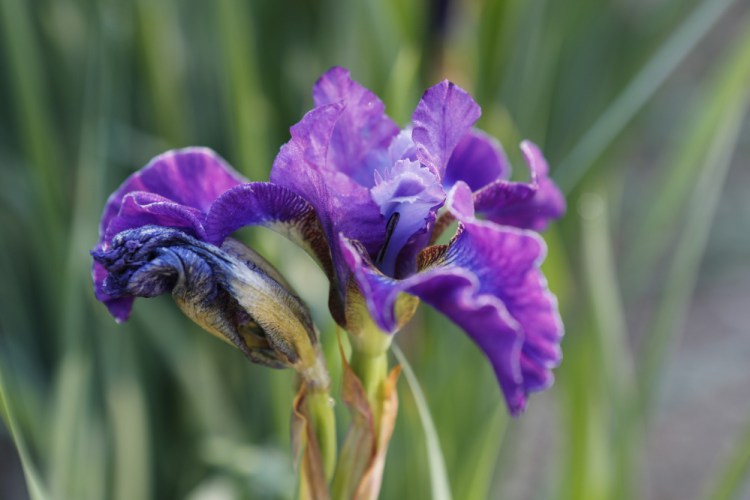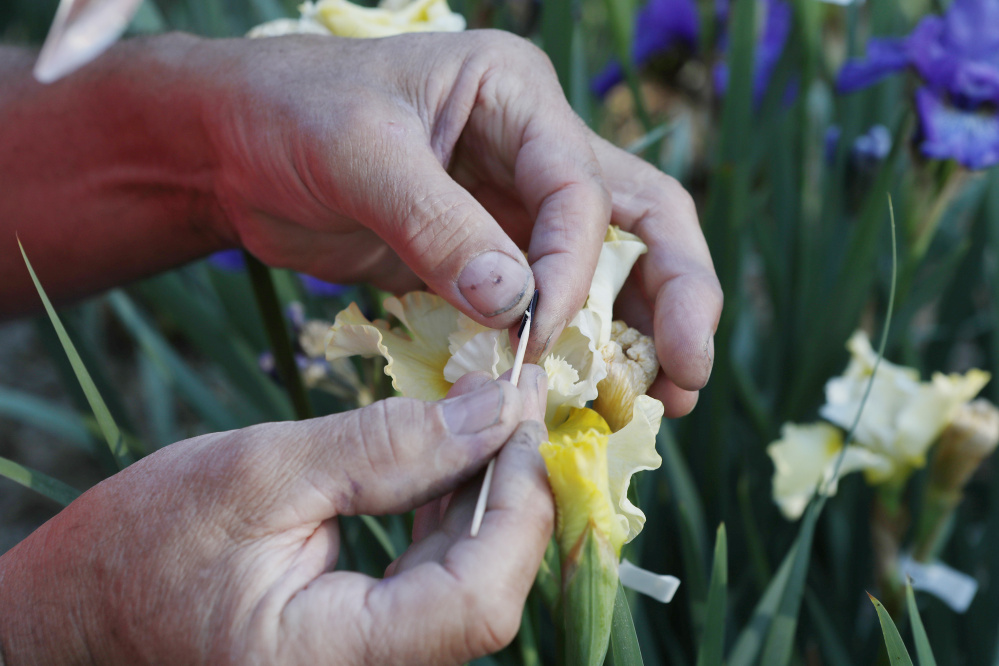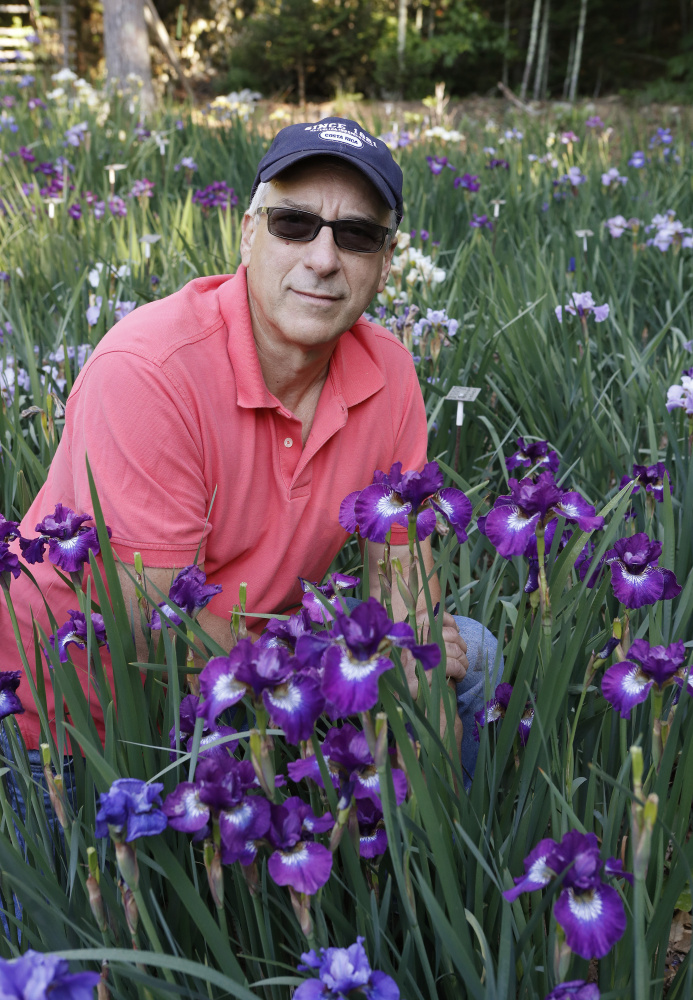Dean Cole loves creating small, beautiful objects. It is his career, crafting jewelry that he has sold since even before he and his wife, Denise, opened D. Cole Jewelers on Exchange Street around 1981. It is also his prime hobby, hybridizing Siberian irises at his Gorham home.
During a recent visit to the family home, I asked Dean if he sees a connection between his career and his hobby. At that moment, Denise was walking by with their 2-year-old granddaughter, who had just spent her first overnight with them. Dean couldn’t think of a connection, at first.
“He likes the fine details in things,” Denise said helpfully.
“I just like creating things,” Dean added after a minute.
Cole began growing irises in the early 1990s, working first in a partnership with Jeff Dunlop of Windham. Although they are still friends, they now work separately. His teacher was celebrated rheumatologist Dr. Currier McEwen, who was dean of the New York University School of Medicine before he moved to Harpswell and launched a second career as a hybridizer of Siberian and Japanese irises. (McEwen died in 2003 at age 101.)
McEwen created the first tetraploid irises, which Cole said have extra chromosomes and therefore deeper and more varied colors, stronger stems and larger flowers than diploid irises, the original species.
Cole grows almost entirely tetraploids, which are more difficult to hybridize. He went into irises because it is an attractive plant, with a lot of variety and – at least when he started – the number of hybrids on the market seemed reasonable. At that time, only 1,600 named iris varieties existed, compared to about 40,000 for daylilies, he said.
Cole’s garden is not a traditionally beautiful landscape, although the area right around the house is attractive. But the iris gardens themselves have a business-like precision, planted in rows of beds with plants all the same age sharing a plot.
The beds are mulched several inches thick with ground-up leaves, which landscaping companies deliver to his property each fall. He grinds them up with a lawn mower, then uses the chopped leaves to suppress weeds, retain moisture and provide organic matter to the plots; he applies only a minimal amount of fertilizer.
Cole does about 750 crosses a year, down recently from about 1,300.
“It’s a lot of work,” he said. “You have to dig each of them.”
He does the hybridizing entirely by hand. He takes pollen from one plant’s anthers, then returns the next day and, using a small white stick that looks like a cross between a Q-tip and a toothpick, puts it on another plant’s anthers.
He wears a magnifying glass attached to his cap to help him see what he is doing, and he writes the crosses on a small tag he puts near the blossom and in a book. Then he covers the blossoms with a plastic cup to protect them from rain.
By the end of the season, each pod will produce about 50 seeds, which he will cold-condition over the winter before planting them in the spring. Each seed will produce a different type of flower.
“They are a lot like children,” Cole said. “You can have five kids with the same parents, and they all look different.”
Hybridizing is not for a person who is afraid of failure, Cole said. About 97 percent of the seedlings are trash.
It takes about a decade from a cross to get to a plant he thinks is worth registering with the American Iris Society. At least three of those years are needed to decide if the hybrid is worth continuing to grow. And then he has to dig and divide the hybrids enough so that he has enough rhizomes to market.
So far, he has brought eight or nine irises to market – he can’t quite recall the number. His favorite is the first one he ever introduced, My First Kiss, which his daughter named. Close behind is My Girl Emily, named for his daughter.
One of his new introductions is Pool Party, a name he picked because the blossom’s blue color resembles a swimming pool.
It isn’t enough for the new plants to be beautiful; they also have to be different. While walking through the garden he pointed to a large, lavender blossom that, while highly attractive, would be useless as an introduction because it resembles so many that are already available.
The original iris species has one bloom on one stem, and lasts about 10 days. Cole showed me one iris he is working on that had several stems with branches, and on the end of one branch was a flower in full bloom as well as two other buds in different stages of growth that would eventually produce blossoms. Such a hybrid could expand the usual bloom time for several weeks.
The size and shape of the blossoms is also important. Larger flowers are better, and it is good to have ruffles, unusual edges and other distinctive features.
Color plays into it, too. Breeders are looking for deeper yellows and multicolored blossoms.
Irises that are called red in catalogs are actually maroon, brown or even purple. A true red iris may be unachievable, Cole said, but breeders are at least working to get closer to that red.
And if he does develop a hybrid with a beautiful and unusual flower, if the stem fails to hold the blossoms above the foliage, it probably won’t please the judges who rate the introductions – even if ordinary gardeners loved it.
“Doc (McEwen) told me early on you have to decide if you want to please the judges or the people,” Cole said.
He sometimes goes with the people.
Tom Atwell has been writing the Maine Gardener column since 2004. He is a freelance writer gardening in Cape Elizabeth and can be contacted at 767-2297 or at tomatwell@me.com.
Send questions/comments to the editors.





Success. Please wait for the page to reload. If the page does not reload within 5 seconds, please refresh the page.
Enter your email and password to access comments.
Hi, to comment on stories you must . This profile is in addition to your subscription and website login.
Already have a commenting profile? .
Invalid username/password.
Please check your email to confirm and complete your registration.
Only subscribers are eligible to post comments. Please subscribe or login first for digital access. Here’s why.
Use the form below to reset your password. When you've submitted your account email, we will send an email with a reset code.